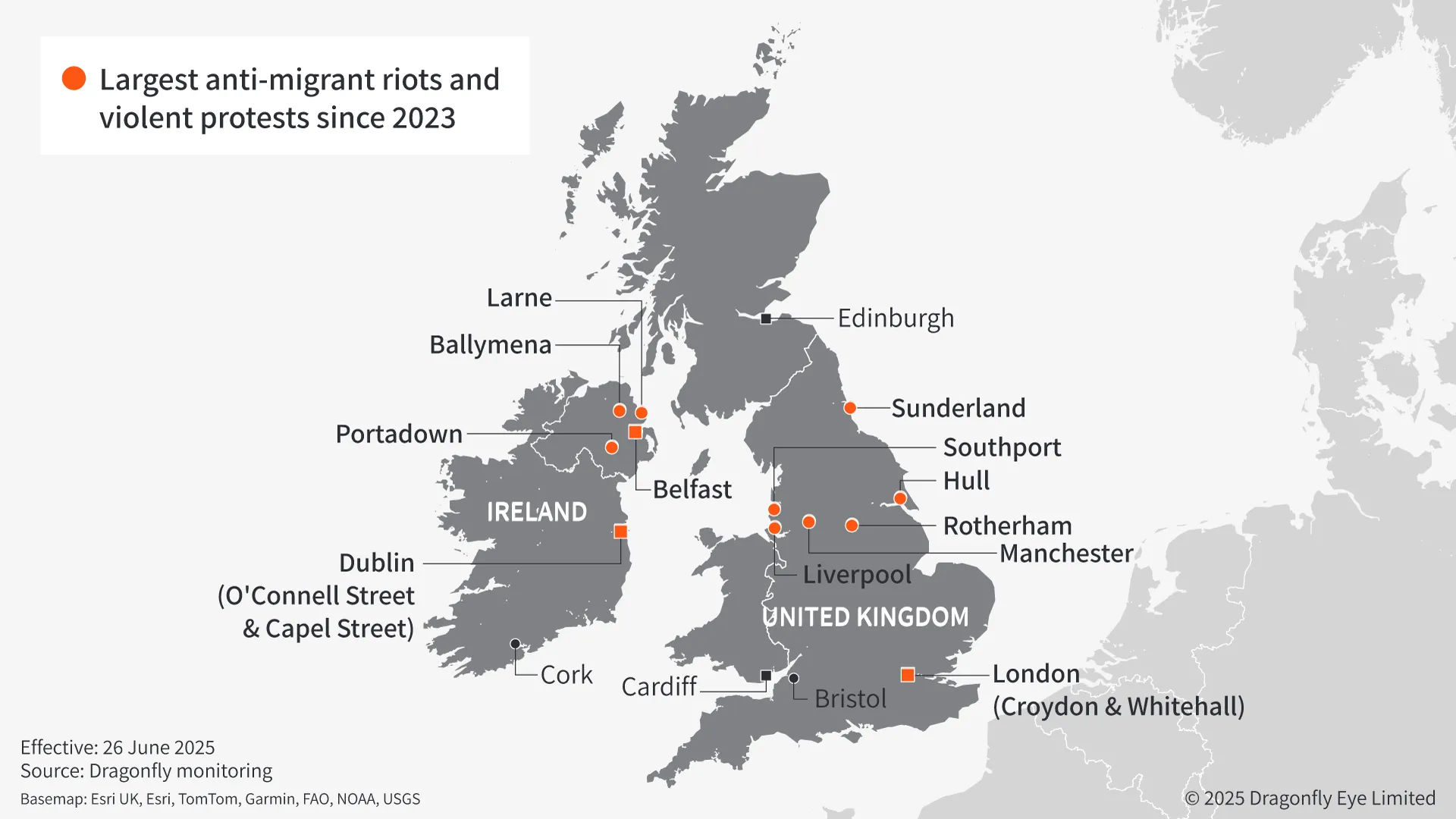Nationalist and far-right activists appear highly intent on encouraging anti-migrant riots and violent protests in the UK and Ireland
This assessment was issued to clients of Dragonfly’s Security Intelligence & Analysis Service (SIAS) on 09 July 2025.
- A few hundred people protested in localities in Ballymena, Northern Ireland, and its vicinity for several days in mid-June over a sexual assault allegedly carried out by two migrants
- Such gatherings are likely to often involve vandalism of buildings and violent altercations with police, but widespread unrest is unlikely for now
Nationalist and far-right activists seem highly intent on encouraging anti-migrant riots in the UK and Ireland. Over the past two years, there have been several bouts of violent protests in both countries in response to crimes that activists have blamed on migrants. Misinformation on social media has amplified public anger over these. Most recently, protesters last month rioted over five days in and around Ballymena, Northern Ireland. Similar circumstances led to widespread unrest in towns and cities in both England and Northern Ireland in July-August 2024 and in Dublin in November 2023.
The criminal incidents that nationalist and far-right activists have mobilised around appear to have been genuine. Given this, it is unrealistic to forecast when such protests will occur again. However, it seems highly likely that when crimes linked to foreign nationals do occur, particularly violent ones, activists will attempt to blame them on ethnic minorities or migrants. Online users have shared mis- and disinformation to stir up anger and disorder.
While typically small, any similar riots in the coming months are likely to often involve vandalism of property and violent altercations with police. These have mostly occurred in residential areas close to where a high-profile crime has occurred, rather than in the centres of major cities. This is partly as gatherings are usually organised by fringe nationalist activists. But many people who espouse these views also seem to have been deterred by mass arrests by the authorities in 2024. As a result, we do not anticipate another period of widespread unrest like in the UK during summer 2024 anytime soon.
Far-right activists online encouraging protests
Anti-migrant protests were particularly prominent during 2024. Based on our analysis of official reports, there were around 29 anti-migrant riots and violent protests across the UK that year. Most of which occurred after a particularly high-profile stabbing in the northwestern town of Southport in July. But that year aside, anti-migrant protests and riots have become gradually more common in the UK and Ireland in recent years; there were ten in the first half of this year, compared with ten during the whole of 2023, and five in 2022.

This rising trend is largely down to far-right and nationalist activists encouraging such protests and riots. Far-right activist Tommy Robinson falsely blamed an ‘asylum seeker’ for the stabbing in Southport and told followers to ‘take to the streets’. In Ballymena last month, messages circulated on nationalist Telegram channels claiming that the two suspects in a sexual assault case could not speak English. And in the run-up to the riots in Dublin in 2023, several nationalist accounts on X shared a post blaming ‘foreigners’ for a stabbing outside a school.
These incidents have given Russia the opportunity to foment unrest. A former UK police official said Russia was ‘involved’ in encouraging the 2024 riots in England. Research by a UK news outlet also claimed that a Russian-linked fake news site, Channel3, incorrectly said the perpetrator in Southport was a migrant. Russia has a track record of using networks of local influencers, fake social media accounts and websites, and bots, with the goal of portraying the authorities as unstable.
Other grievances also appear to be contributing to the occurrence of anti-migrant protests. In our analysis of activists’ online rhetoric, a significant portion of protesters are increasingly aggrieved over fast demographic change in the UK and Ireland, and economic issues, like housing. These issues often bring together disparate groups, like nationalist networks, local vigilante groups, disaffected youth in working-class communities, as well as some Republicans and particularly Loyalists in Northern Ireland.
Protests most likely in deprived, residential areas
Anti-migrant riots and violent protests tend to occur in disadvantaged residential areas near the location of high-profile crimes that activists have tied to foreign nationals. During the riots that began in Ballymena last month, unrest was largely confined to deprived residential areas in towns and their vicinity, such as in Antrim, Carrickfergus, Larne, Newtonabbey and Portadown. Even during the 2024 riots, most unrest occurred in deprived suburban areas, such as Manningham in Bradford and Maltby in Rotherham. Most riots have attracted a few hundred people, but a few have run into a couple thousand.
For now, high-profile or shocking violent crimes that are blamed on immigrants appear to be the most probable trigger for such unrest. But the emergence of reports that the authorities are planning to house migrants in an area with strong nationalist sentiment is another development that far-right activists online would probably try to exploit; during the 2024 riots, some activists protested at hotels that migrants had reportedly been moved to recently.
Other potential triggers for unrest we are monitoring are government investigations into alleged miscarriages of justice. These include the government’s inquiries into the Southport stabbing and Group-based Child Sexual Exploitation and Abuse (‘grooming gangs’). In the latter, some activists have blamed the police for protecting men of Pakistani origin from investigation. Based on where unrest spread in 2024, riots prompted by this would most likely occur in working class areas of places such as Belfast, Bradford, Rochdale (where one child sex abuse ring operated), Rotherham, Southport and Sunderland.
High likelihood of protests turning violent
Anti-migrant protests are very likely to turn violent. Recent precedent suggests disorder tends to involve activists throwing projectiles at and fighting with police, burning vehicles and starting street fires with debris. Riot squads are often deployed, who at times use water cannon to disperse protesters (rubber bullets have been used in two cases). Acts of vandalism and looting of nearby properties and retailers are also common during unrest, but usually remain confined to low-income residential areas.
In more severe cases, such as in parts of Northern Ireland last month, fringe activists have conducted arson attacks on nearby buildings they perceive as housing, supporting, or being run by migrant communities.
Counter-protests are common in Belfast, Cardiff, Birmingham, Bristol, Liverpool and London. Such gatherings typically take place in these cities regardless of where anti-migrant riots are occurring, due to a strong left-wing activist presence. Police are effective at policing these, and so avoiding any broader disorder.
Widespread unrest improbable this year
We do not anticipate widespread anti-migrant riots in city centres in UK and Ireland in the coming months. The authorities arrested nearly 800 participants for their participation in the 2024 riots. Based on our monitoring of activist channels, this response by the authorities seems to be still deterring activists from joining protests other than spontaneous ones in their local areas.
Image: Fireworks thrown at Riot Police illluminate the road during a thrid night of anti-immigration demonstrations in Ballymena, Northern Ireland, on June 11, 2025; Photo by PAUL FAITH/AFP via Getty Images.




